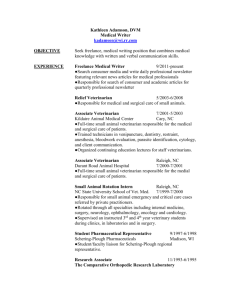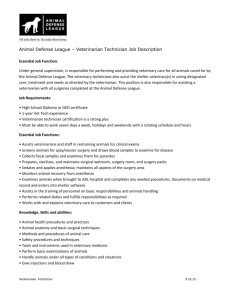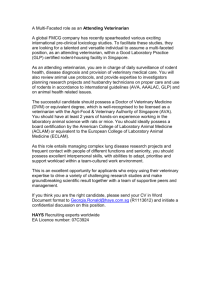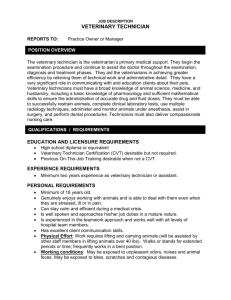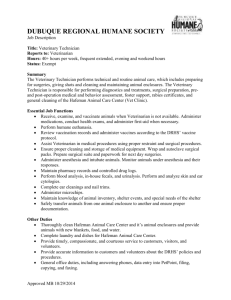Veterinary Assisting
advertisement
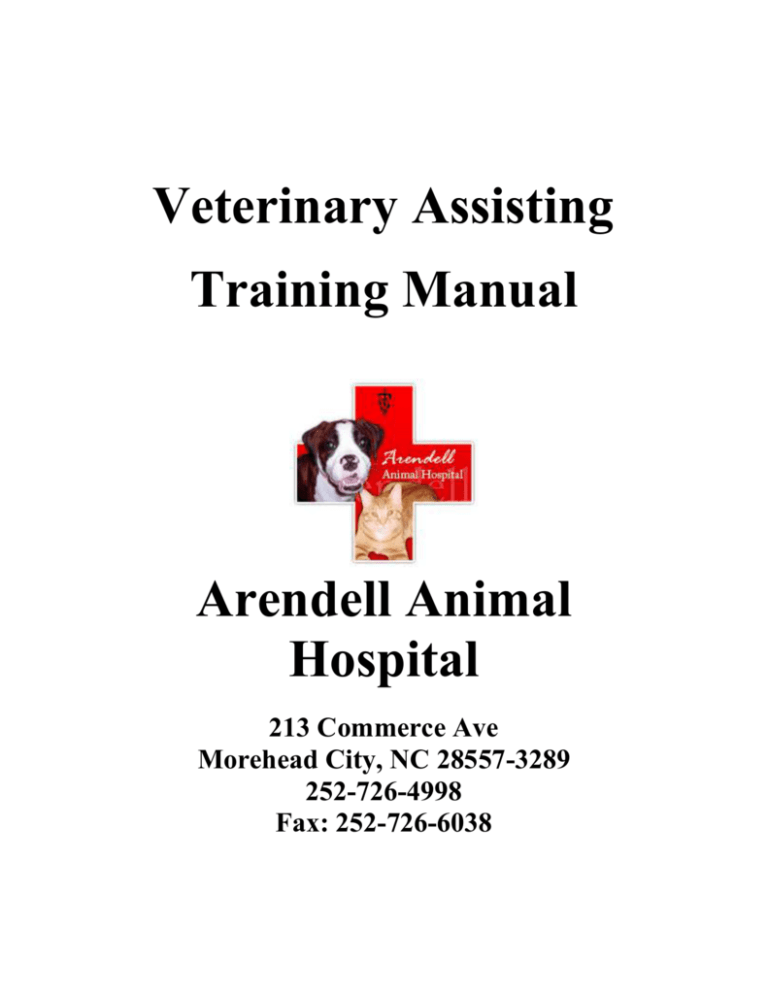
Veterinary Assisting Training Manual Arendell Animal Hospital 213 Commerce Ave Morehead City, NC 28557-3289 252-726-4998 Fax: 252-726-6038 Introduction The structure of the Veterinary Health Care Team starts with the licensed veterinarian. The staff that works under him/her may include: 1. The Veterinary Technician An individual who has graduated from a 2 or 3 year AVMA accredited program in veterinary technology. Her/his role is that of providing professional assistance to veterinarians, biological research workers, and animal control and humane organizations. Her/his duties shall be performed under the responsible or immediate supervision of a licensed veterinarian. Their knowledge base must include normal and abnormal life processes of animals, medical, surgical and critical care nursing, anesthesiology, radiology and clinical laboratory procedures. 2. The Veterinary Assistant An individual in whom training, knowledge, and skills are less than those required for identification as a veterinary technician or veterinary technologist. Performs variety of animal health care duties to assist Veterinarian and/or veterinary technician in settings such as veterinarians' clinics, zoos, research laboratories, kennels, and commercial facilities. Their job duties include some of the following: feed, water, and examine pets and other nonfarm animals for signs of illness, disease, or injury in laboratories and animal hospitals and clinics. Clean and disinfect cages and work areas, and sterilize laboratory and surgical equipment. May provide routine postoperative care, administer medication orally or topically, or prepare samples for laboratory examination under the supervision of veterinary or laboratory animal technologists or technicians, veterinarians, or scientists. 3. The Receptionist These individuals are in charge of the clerical and office procedures that are routinely performed in the daily operations. 4. The Kennel Attendant These individuals are vital in basic animal husbandry. Their job duties include proper cleaning of kennel areas as well as observation of patients. 5. The Practice Manager In charge of the complete functioning of the practice, they analyze finances, employee assignments and job duties, education and development of protocols with the purpose of providing the highest quality of animal care, best utilization of personnel and highest profitability for the practice. This is a manual for the Veterinary Assistant here at Arendell Animal Hospital. This is your training manual. Tasks Appropriate to Delegate to the Assistant When identifying those tasks which are appropriate for an assistant to complete, the determining factor in assigning tasks to the assistant is the impact of the task on a positive patient outcome. In developing the following list of tasks which the assistant may be trained to perform, each task was evaluated for appropriateness based on, but not limited to, the following criteria: 1. What is the impact of the task on a positive patient outcome? 2. Could/would the average client perform the task? 3. Does it change the physiologic state of the patient? 4. Does the information obtained, impact the veterinarian’s diagnosis? It is essential to remember that the completion of all assistant tasks requires some degree of supervision either by the veterinarian or the credentialed veterinary technician. The following delineation of tasks, appropriate for delegation to the assistant on the veterinary health care team, was developed through a cooperative effort between NAVTA, the Association of Veterinary Technician Educators (AVTE), and the AVMA’s Committee on Veterinary Technician Education and Activities. Educating assistants on tasks beyond the scope of this list is discouraged. Essential Skills for Assistant Training I. Office and Hospital Procedures A. Front Desk 1) Greet Clients 2) Demonstrate proper Appointment Scheduling and make appointments 3) Prepare appropriate certificates for signature 4) Admit patients 5) Perform basic filing and retrieving of medical records 6) Perform basic veterinary medical record keeping procedures 7) Demonstrate elementary computer skills 8) Utilize basic medical terminology 9) Perform basic invoicing, billing, and payment on account procedures B. Telephone 1) Answer and direct phone calls 2) Recognize and respond appropriately to veterinary medical emergencies, by notifying the appropriate hospital personnel 3) Request records and information from other veterinary facilities C. Maintain basic cleanliness and orderliness of a veterinary facility 1) Inventory supplies 2) Restock Shelves 3) Maintain x-ray, surgery, and laboratory logs 4) Perform basic filing and retrieving of medical records, radiographs, lab reports, etc. 5) Demonstrate knowledge of basic cleaning techniques of animal kennels and bedding, examination rooms, hospital facilities, and surgical suites. II. Communication and Client Relations A. Develop effective client communication skills. B. Write business letters. C. Understand ethical conduct in relationship to the day to day operations of a veterinary hospital. D. Describe the roles and responsibilities of each member of the veterinary health team and the important part that each plays in the delivery of excellent care. III. Pharmacy and Pharmacology A. Legal Issues 1) Recognize legal issues involving drugs in the workplace 2) Recognize general types and groups of drugs and demonstrate proper terminology 3) Differentiate prescription drugs from over-the-counter drugs and describe proper prescription label requirements B. Filling medications and inventory control 1) Label and package dispensed drugs correctly. 2) Store, safely handle and dispose of biological and therapeutic agents, pesticides, and hazardous waste. 3) Perform inventory control procedures including restocking supplies and checking expiration dates. C. Vaccinations 1) Reconstitute vaccines and be familiar with proper protocols. 2) DESCRIBE possible routes and methods of drug and vaccine administration that the veterinarian or veterinary technician may choose. IV. Examination Room Procedures A. Restrain Patients 1) Small Animals b. Place and remove small animals from cages c. Place and restrain small animals on tables d. Apply dog and cat safety muzzle e. Apply Elizabethan collar f. Apply restraint pole 2) Restrain Birds and Exotics - optional 3) Large Animals - optional a. Halter, tie, and lead horses and cattle b. Restrain cattle & horses c. Apply twitch d. Apply nose tongs/leads e. Restraint sheep & swine f. Load large animals. B. Basic Procedures 1) Determine and record Temperature, Pulse, Respiration, and Weight of pets 2) Trim nails (dogs, cats, and birds) 3) Express anal sacs using the external method 4) Identify external parasites: mites, lice, fleas, ticks 5) Recognize common dog and cat breeds 6) Bathe and groom animals 7) Be familiar with small animal nutritional requirements V. Surgical Preparation and Assisting A. Assist in Performing surgical preparations 1) Prepare surgical equipment/supplies 2) Sterilize instruments & supplies using appropriate methods 3) Identify common instruments 4) Identify common suture materials, types, and sizes 5) Assist the veterinarian and/or veterinary technician with preparation of patients using aseptic technique 6) Operate and maintain autoclaves 7) Describe operating room sanitation & care 8) Assist with positioning of surgical patients 9) Aid the veterinarian/and or veterinary technician with physical monitoring of recovering surgical patients B. Facility and Equipment Cleanliness 1) Maintain proper operating room conduct and asepsis 2) Perform post-surgical clean up 3) Fold surgical gowns and drapes C. Have knowledge of: 1) Surgical equipment 2) Surgical room and prep area 3) Instruments 4) Proper disposal of hazardous medical wastes VI. Small Animal Nursing (Large Animal Nursing - optional) A. Safety Concerns 1) Demonstrate knowledge of basic normal and abnormal animal behavior 2) Utilize patient & personnel safety measures 3) Identify potential Zoonotic diseases 4) Describe Isolation procedures 5) Describe hazardous waste disposal 6) Describe basic sanitation B. Animal Care 1) Provide routine record-keeping, and observation of hospitalized patients, I.E. stress importance of notations made when cleaning and feeding 2) Demonstrate a basic understanding of common diseases and medical conditions 3) Monitor/restrain patients for fluid therapy and record observations 4) Hand pilling (dog, cat) 5) Apply and remove bandages to healthy animals - (equine leg and tail wraps optional) 6) Perform therapeutic bathing, basic grooming, and dipping of small animals 7) Clean external ear canals 8) Prepare food & prescription diets - be aware of any special dietary needs 9) Clean & disinfect cages, kennels, & (stalls - optional) 10) Provide care & maintenance of nursing equipment VII. Laboratory Procedures A. Technical Assistance in the laboratory 1) Collect voided urine samples 2) Determine physical properties of urine including color and clarity 3) Assist in the collection of blood samples for procedures 4) Collect voided fecal samples for parasitologic exam 5) Prepare fecal flotation solutions and set up fecal flotations 6) Assist in necropsy procedures 7) Explain how to handle rabies suspects & samples safely 8) Handle disposal of dead animals B. Laboratory Record Keeping 1) Ensure all lab results are accurately recorded 2) Stock lab supplies 3) File lab reports VIII. Radiology & Ultrasound Imaging A. Follow recommended safety measures B. Assist the veterinarian and/or the veterinary technician in the completion of diagnostic radiographs and ultrasound including the restraint and positioning of patients C. Process diagnostic radiographs D. Use hand and automatic processing in darkroom E. Maintain quality control F. Label, file, and store film and radiographs G. Properly care for equipment H. Clean screens I. Know safety techniques for handling chemicals Insert Veterinary Assistant/Receptionist Training Check Off Sheet Here Office Procedures and Paperwork Remember you are often the first representative of our practice the client encounters and therefore their first opinion of our hospital will be based on your behavior. At all times we want to act in a very professional manner. Always greeting the client with respect. When asking them to fill out paperwork be sure to explain carefully and offer assistance and be patient. 1) Phone Duties At all times answer the phone clearly and calmly identifying the name of the clinic as well as your first name. Ask how you may help them. If you have someone on another line ask “Is this an emergency or can I place you on hold?” For example: “Arendell Animal Hospital this is DeAnne, how may I help you?” or “Arendell Animal Hospital this is DeAnne, is this an emergency or May I put you on hold?” Again we are always to act in a professional manner. 2) Setting appointments If in doubt put client on hold and ask! a) Boarding Appointments: Be sure to remind the client of the vaccination requirements for all boarders including the time frame for example for Bordetellaanimal should have been vaccinated preferably 3-5 days before boarding. Obviously rabies and other vaccinations need to be current. b) Patient Appointments Be sure to double check so you don’t overlap appointments or schedule when doctor or tech is unavailable. Check to see if client/patient has a scheduled appointment. We will always try to work patients in but we need to be sure to let them know if there is going to be a wait- offering to schedule a convenient time for them to return. Obviously emergencies are seen ASAP. * Important: If we can see them at this time, be sure to place their names and the patient name in the appointment book for the time slot they will be seen. Intake Forms 1) Client Financial Information The client information sheet is essential so we must make sure it is completely filled out. We cannot begin to work on an animal until we have owner information as well as financial responsibility information. * This includes consent form signatures. Be sure there is contact information preferably two phone numbers. *Obviously if an animal is brought in by a Good Samaritan, police or rescue officer and needs immediate emergency care we will provide that service but still make sure whoever brings the animal in fills out their information- stating they are not the owner therefore not assuming financial responsibility. In every instance the practice manager, DeAnne or Dr. Hawkes is to be notified before the person leaves in case there are any questions they may have. 2) Patient Information It is essential we get complete information identifying the patient. This is especially important if the client has more than one animal. Breed, age and color are the minimum essentials as well as sex* and whether neutered or in tact. * Note: the first time an animal is brought in to the hospital verification of sex should be made by the assistant, tech or veterinarian as clients have been known to mis-identify the sex of their animals. This is especially true with kittens and cats. Medical Terminology TPR: Temperature, Pulse Respiration Strabissmus: lateral movement of eyeball, uncontrolled TPR: Temperature, pulse and respiratory rate BAR: Bright, alert and responsive (happy animal who is aware of its surroundings – this is an animal who is not acting very sick) QAR: Quiet, alert and responsive (still aware, but not as happy, maybe feeling a little under the weather or stressed) OS: Left eye OD: Right eye OU: Both eyes AS: Left ear AD: Right ear AU: Both ears d/c: discharge v/d: vomiting/diarrhea c/s: coughing/sneezing Note: The abbreviations “S” for left and “D” for right date back to the days when left handed people were considered Sinister while right handed people were admired for their Dexterity. The “U” can be thought of as standing for Universal. Physical Exam The first part of the physical exam consists of questions, basically a questionnaire to determine the reason for the visit. The second part is the actual preliminary physical exam. Patient Intake Questionnaire = History (Hx) - (see Patient History Form) Includes geographic origin and prior ownership, current environment, diet, past medical history, breeding history, vaccination status and current medications. Description and history of chief/presenting complaint Reported concerns should be followed up with additional questions to clarify nature of the complaint Ask client the following: 1) 2) 3) 4) 5) What brings them here today (This is the Presenting Complaint) Symptoms: stools, urination, eating, vomiting, pain, depression Duration of symptoms Onset Ask if the brought stool specimen (we always would like to ck for parasites) 6) Vaccination history 7) Dental history a) TPR (temperature, pulse, respiration), weight* *Weight is often taken before patient is brought in to the exam room. This will depend upon which scale you need to use. Take temperature- record Take pulse- record Take respirations- record Be sure to note if animal is uncomfortable being handled and never hesitate to ask for assistance. If the animal is very excited and has been ill it is often best to not excite it further before the veterinarian can exam it. This is especially important in animals that have fevers and are I pain. In this case note on patient sheet status- too excited- uncomfortable, no temp taken, for exampleRemember at all times your safety and the animal’s safety are paramount. Do not try to handle an animal you are uncomfortable with. Always ask for help. TPR- Temperature, Pulse and Respiration Temperature A temperature can be taken by ear (aural), underarm (axillary), toe web or rectal which is the most common approach. An animal's body temperature can tell us several things. Pyrexia, or hyperthermia, is when the temperature is above the normal range. Stress can cause a slightly elevated temperature, but other conditions such as infection, heat exhaustion, seizures and certain toxicities can also cause an elevation. Hypothermia, low body temperature, can be caused by conditions such as shock, metabolic crisis, environmental conditions, and anesthesia. If a body temperature is out of the normal range, notify the veterinarian. It is important that the animal's temperature is not adjusted in a quick manner. If there is a rapid change in temperature, it could cause serious problems for the patient. For instance, rapid cooling down can lead to a severe coagulopathy, which is a defect in clotting mechanisms. Rapid heating can cause vasodilatation, an increase in the diameter of the blood vessels, which results in lowering the blood pressure of the animal. Both of these conditions can be fatal to the animal. In some cases it is not important to correct the body temperature, but if external heating or cooling sources are necessary, the temperature should be adjusted slowly and ceased once the animal is within two degrees of normalcy. Pulse The heart beating and moving blood throughout the arteries and vessels causes the pulse. For each heart beat there should be a pulse that follows. The most common areas to palpate pulses are the femoral artery, the axillary artery, and the dorsal metatarsal artery. The strength or amount of force (quality) of the pulse should be observed. If the pulse is very strong or bounding, it can be indicative of hypertension (high blood pressure). Toxicity, compensatory stage of shock, trauma and pain, renal disease, hyperthyroidism and Cushing's Disease can all cause strong or bounding pulses. If the pulse quality is weak or poor, it can be indicative of hypotension (low blood pressure) or poor perfusion. Toxicity, early/middle/terminal stages of shock, anemia, active bleeding (hemorrhaging), poor perfusion and end-stage disease are all causes for poor pulse quality. The heart sounds should also be assessed with the pulse. The rhythm of the pulse should correspond with the heart beating. To properly assess the rhythm, one must listen to the heart with a stethoscope (auscult) while monitoring the pulse. There should be one pulse felt for each heartbeat heard. A pulse deficit is when there is no pulse to follow a particular heartbeat. This has a potential to be a life threatening condition and the veterinarian should be notified immediately. Other rhythms that may be observed are sinus arrhythmia, sinus bradycardia and sinus tachycardia. Sinus arrhythmia, which is not abnormal and commonly seen in dogs, is when the heartbeats correspond with the respiratory pattern. The heartbeat frequency increases with inspiration and decreases upon expiration. Sinus bradycardia is a slow sinus rhythm where the heartbeats per minute are below normal range. This can be an indicator of certain conditions such as a heart block, Sick Sinus Syndrome, hypothermia, and the influence of anesthesia or post surgical recovery. Sinus tachycardia is a fast sinus rhythm where the heartbeats per minute are above the normal range. Pain, shock, anxiety, and hypotension can cause sinus tachycardia. Heart murmurs (caused by a cardiac valve dysfunction) are another abnormal cardiac sound. Some animals develop murmurs during illness, in which the murmur goes away once the patient has recovered. A murmur will have a "whoosh" sound instead of clear, distinct heart sounds the normal healthy cardiac patient has. There are different degrees of murmurs in which the veterinarian will classify. Muffled heart sounds, where the heart does not sound clear when ausculted, can be associated with fluid in the thoracic cavity. An absence of heart sounds can be due to position of either the stethoscope or animal, but also is a sign of a pericardial effusion. A pericardial effusion is accumulation of fluid within the pericardium (sac that surrounds the heart) and results in decreased cardiac output. Trauma or disease can cause a pericardial effusion and it is fatal if not treated. Veterinary technicians should practice ausculting the hearts of animals that come into the clinic. If it's understood what normal heart sounds are, they will be able to aid the veterinarian in recognizing abnormal sounds when they arise. Respiration Respiration, or breathing, is the exchange of oxygen to carbon dioxide via the lungs. The respiratory system consists of the upper (oronasal) and lower systems (bronchi and lungs). Oxygen is the most important element to administer in an emergency or critical situation in which the animal is in respiratory distress as no living being can survive without it. It is important to remember that a patient in respiratory distress can succumb due to stress at any point and handling should be minimized until the patient is stable. Signs of respiratory distress (dyspnea) include cyanotic (purple/blue) colored mucous membranes (gums, conjunctivae, etc.), rapid or rapid and shallow breathing (tachypnea), neck extension, labored breathing, abdominal effort, open mouth breathing or gasping for air, and having "hunched back" position. Upon observing the respiratory pattern, one can usually determine the area of the respiratory system affected. An increase in inspiratory effort, marked with open mouth breathing or gasping motions usually correspond with an upper airway condition. There may be a notable sound, usually harsh or high pitched, that is audible without a stethoscope. This is called a stridor and is the most common sound associated with upper airway conditions. Some conditions that may cause a stridor or an increase in inspiratory effort include upper airway obstructions, upper respiratory infections, laryngeal paralysis, and tumors/masses and collapsing trachea. An increase in expiratory effort, marked with an increase in abdominal effort or contracting, is indicative of a lower respiratory condition. Some conditions associated with abdominal breathing and expiratory distress are ride side heart disease, ascites (accumulation of serosanguineous fluid in the abdomen), hemoabdomen (accumulation of blood in the abdomen), abdominal tumor, diaphragmatic hernia, Acute Respiratory Distress Syndrome (ARDS) and pneumonia. Certain conditions may have little or no inspiratory or expiratory effort however the animal still may be in respiratory distress. Watching the pattern is important. Shallow, fast respirations are associated with conditions such as a pneumothorax (air in the pleural cavity) and a pleural effusion (fluid in the pleural cavity) in which there may be a hydrothorax (clear transudate), pyothorax (purulent), chylothorax (white/pink), or hemothorax (red/frank). Animals with asthma, pulmonary contusions or pulmonary thromboembolism (PTE) can appear to have severe inspiratory and expiratory effort at the same time, along with open mouth breathing and tachypnea. Upon asculting the lungs, breath sounds should be heard for both inspiration and expiration. As with the heart, it is a good idea to listen to normal, healthy lungs of several animals so abnormal breath sounds can be recognized. Common abnormal sounds that may be noted are wheezes (whistling) and crepitant and crackling rales (popping or bubbling sounds). Wheezes are associated with bronchitis and asthma. Crepitant and crackling rales are associated with fluid in the lungs (pneumonia, pulmonary edema, near drowning, etc.). It is important to note which side of the thorax the sounds were observed, and whether it was the cranial (toward the head) or caudal (toward the tail) area of the thorax, and whether the sounds were heard upon inspiration or expiration. This will help the veterinarian determine which lung lobe is affected. If no lung sounds are heard upon auscultation, a veterinarian should be retrieved immediately as this is a classic sign associated with a pneumothorax. Again, keep in mind that stethoscope or patient position may be the cause as well. Normals Canine Feline Temp 99.5- 102.5 100.4 -102.5 Pulse 70-160 110-200 Respiration 10-30 24-42 VITAL SIGNS – Evaluated in relation to presenting complaint, history and current health status Body Weight All animals < 20 lbs should be weighed using a pediatric/small animal scale Any animal < 5 lbs or > 75 lbs must be examined by supervisor to be cleared for surgery Temperature: Via rectal thermometer Normal: 99.5-102.5 °F Examine rectal area for signs of diarrhea, parasites or other abnormality. Any temperature < 99 °F or > 105 °F warrants immediate evaluation by a supervisor. A patient whose temperature is 103-104.5 °F, who is excited/overactive and has no other signs needs to be allowed to calm down, then have temperature retaken later (after questionnaire and exam) to see if it has normalized Most animals will resist having their temperature taken. Complete the rest of the exam before obtaining a temperature to avoid agitating the animal and making examination more difficult. Do not struggle with an aggressive animal to obtain a temperature. If having difficulty taking an animal’s temperature consult a supervising veterinarian or staff member. Heart/Pulse rate Normal: K9: 70-160 bpm; Fe: 110-200 bpm Evaluate pulse at femoral artery Evaluate pulse rate, strength and quality (e.g., strong, weak, thready, bounding) Compare both sides and heart rate: pulse rate < heart rate = pulse deficit Respiratory rate and character Normal: K9: 10-30 bpm; Fe: 24-42 bpm RR determined visually or by auscultation. Count either inspirations or expirations. Perfusion Indicators - (see ‘Assessing Mucous Membrane Color’ below) Mucous membrane color (MM)-provides indication of the blood flow to peripheral tissues. Capillary refill time (CRT) - reflects perfusion of peripheral tissues Press on an area of mucous membrane. The gums will "blanch" white as they are pressed and become pink again when pressure is released. Normal: < 2 seconds Prolonged CRT (> 2 seconds) may indicate compromised circulation due to cold, shock, cardiovascular disease, anemia or other causes Signalment Complete description of the animal Species, Breed, Age, Sex, Reproductive status, other distinguishing characteristics Always double-check client reported information (sex, age, etc) Keep this information in mind as you examine the animal and make clinical judgments. GENERAL APPEARANCE / INITIAL OBSERVATIONS (GA) General appearance – observe animal from a distance and up close before any handling Symmetry - note any asymmetry; note any difference in size or shape of extremities Body condition / State of nutrition (see Purina Small Animal Body Condition Scoring chart) Assign appropriate Body Condition Score using standard nine point scale (BCS = 1-9) In general, the animal is too thin of his ribs are easily seen, normal if they are readily felt without a layer of fat lying over them and obese if it is difficult to feel them at all Mentation / Level of consciousness – attentiveness / reaction to environment- Alert and responsive – Depressed – Uncontrolled hyperexcitability – Stupor – Coma e.g: Normal healthy animal's mentation is often bright, alert and responsive or "BAR". A healthy puppy may be described as "active and playful," while a sick puppy may be "moderately depressed and inactive" Posture and gait - watch the animal walk to exam area or kennel. Look for limping, incoordination or unsteadiness and abnormal limb placement. Hydration status - (see ‘Assessing Dehydration’ below) Expressed as percentage of body weight (0-15%) Loss of the elasticity of the skin (skin turgor) is first sign of dehydration. Check the skin of the upper eyelid and the neck for tenting Dehydration is expressed as a percentage of body weight. Signs of dehydration are more difficult to see in some animals. Skin may "tent" more in emaciated animals and certain breeds (such as Bassett Hound or a Chinese Sharpei). Obese animals may not have skin tenting even when they are dehydrated. Some physical exam oddities: Blue tongue (or blue spots on tongue) chow or chow mix Two different eye colors Australian shepherds among some other dogs Manx Cats- short or absent tail Animal Restraint Often times you will be asked to restrain the animal for examination or procedures done by the veterinarian or tech. Clients are only rarely allowed to holdIn the interest of safety, safety for the patient, client, assistants, veterinarians and techs we do NOT let owners hold with very few exceptions. (See veterinarian/manager/tech for clinic exceptions.) 1) Gentle but firm restraint is best. Try not to overpower the animal in such a way as to immediately set up its defenses. Gentle quiet reassurance is what the animal needs. At all times keep your face away from bite zone. Remember, however, that sometimes the best restraint is light or moderate restraint, which decreases the amount of stress on the animal. 2) Say Hello - Remember to socialize yourself with the animal before abruptly starting the examination. Taking a few moments to develop a relationship with the animal will save time and stress later. 3) 4) 5) 6) Feline restraint Canine restraint Mechanical restraint Chemical restraint

